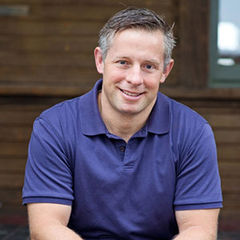Anabolic steroids are usually associated with illegal performance-enhancing drugs that athletes take when trying to get an edge on the competition, but the truth is that we all have anabolic steroids in our bodies. In fact, anabolic steroids such as testosterone, which is naturally produced by the body, are essential for building muscle and increasing strength. Read on to learn seven things about testosterone and how you can use exercise to increase your body’s ability to produce it.
1. Anabolic refers to a hormone the body produces that promotes growth (by contrast, catabolic hormones are those that break down a substance into smaller components). A steroid hormone interacts with receptors in the nucleus of a cell, while a peptide hormone works with receptors on a cell membrane. Testosterone is an anabolic steroid the body produces that, in addition to other functions, promotes muscle growth by interacting with receptors in the nuclei of muscle cells to help repair muscle proteins damaged during exercise.
2. Testosterone is also an androgen that promotes sexual development in men. Testosterone is produced primarily in the Leydig cells of the male testes. Women can produce testosterone in the ovaries and adrenal glands; however, they produce much less than men, which means the fear of developing “bulky muscles” from two strength-training workouts per week are unfounded and scientifically impossible. The synthetic testosterone taken by those looking to promote rapid muscle growth is called exogenous androgen because it is a substance produced outside of the body. Whether you want to call it an anabolic steroid or an androgen, both are correct, testosterone is a completely natural substance that enhances muscle growth as part of the normal post-exercise repair and recovery process.
3. As you age, your body will produce less testosterone. Andropause affects men over the age of 30, causing them to produce less testosterone.
4. But here’s some good news: According to the research, certain types of exercise can help your body produce testosterone, even in the later years of the adult lifespan. A study by Baker and colleagues, for example, had. three groups of men separated according to age (20-26 years, 38-53 years and 59-72 years) perform the same strength training program of six exercises using 80% one repetition maximum for three sets of 10 repetitions. Each group had blood drawn before and after the workout to measure how the exercise influenced testosterone production. Prior to the workout the younger group had a higher level of Testosterone, but after the workout, all three groups showed an increase in the hormone. These findings suggest that you should make high-intensity strength training a consistent part of your exercise program if you want to maintain testosterone in your body during the aging process.
5. Even if you are a little older and have been sedentary for a period of time, research suggests high-intensity interval training (HIIT) can help improve the production of free testosterone. In this study, 22 sedentary male participants (average age: 62 years) performed a total of nine HIIT workouts on a bicycle ergometer; each workout consisted of six sprint intervals of 30 seconds each followed by three-minute recovery intervals. Participants’ total testosterone increased by an average of 17% as a result of the HIIT. The authors suggested that “HIIT appears [to be] a sufficient stimulus to improve free-Testosterone in lifelong sedentary aging men.”
6. Multiple sets of strength-training exercises performed to the point of fatigue could be an effective strategy for enhancing testosterone production. According to a literature review by Kraemer and Ratamess, strength training causes the body to make four specific adaptations as it relates to testosterone production: (1) acute changes during and within the first 30 minutes post-exercise; (2) long-term changes that increase resting levels; (3) long-term changes in how efficiently the body produces testosterone as the result of exercise; and (4) an increase in the number of receptor sites that interact with testosterone. As receptor sites increase, there is a better chance that the elevated levels of circulating testosterone post-exercise will have a positive effect on muscle growth. The researchers concluded that a high volume of high-intensity strength training that engages large amounts of muscle mass combined with relatively short rest intervals of one minute or less helps to promote testosterone production.
7. Enhancing the metabolic effect of strength training by reaching a point of fatigue can be an effective way to ensure that the body produces enough testosterone to promote muscle growth. In a review of the research literature, Vingren and colleagues noted that heavy strength training promotes both total testosterone and free testosterone (the levels of the hormone circulating through the bloodstream that can attach to the binding proteins responsible for carrying it to receptor sites in cell nuclei). The researchers suggest that to promote testosterone, exercise selection should focus on compound movements with shorter rest intervals.
While the body does produce less testosterone over the lifespan, exercising to a point of fatigue for either strength or cardio is essential for testosterone production. And here’s a bonus tip: Testosterone is produced during the REM cycles of sleep, which means that practicing good sleep hygiene is essential for optimizing the repair and recovery process, particularly on the days when you schedule your most intense workouts. On the other hand, if you have big plans in the evening that might disrupt your normal sleep pattern, consider scheduling a lower-intensity workout because there’s no sense pushing yourself in the gym if your body won’t have the opportunity to experience optimal muscle repair while you sleep.




 by
by 






 by
by